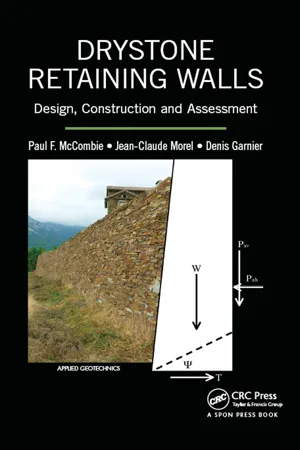Structures built from carefully stacked stone, without any form of mortar, have been used throughout history for buildings and boundary structures, and for supporting terraces for agriculture, buildings and roads. They are an essential part of many monuments that have been designated as World Heritage Sites, such as Great Zimbabwe National Monument in Zimbabwe (1986) or the Historic Monuments of Ancient Nara in Japan (1998). Within France and the United Kingdom, a substantial proportion of retaining walls on roads are constructed of drystone: about one-sixth of road gravity retaining walls in France (Odent 2000) and about half of highway retaining walls in Great Britain (O’Reilly et al. 1999).
These structures have a long life. The drystone walls at Great Zimbabwe Monument were constructed in the eleventh century, and most road drystone retaining walls in France and the United Kingdom date from the nineteenth and the early twentieth centuries. However, the constituent materials are subject to weathering, especially to frost damage in colder climates, and so deteriorate over long periods. Poor repairs, especially pointing and grouting, can accelerate the deterioration by holding water within the structure, leading to accelerated weathering or even catastrophic collapse if significant pore pressures build up. Imposed loadings can be much higher than in the past due to increasing axle loads of modern vehicles, and even impact damage (Gupta and Lohani 1982).
Repair using appropriate methods or even full reconstruction may be needed. In the case of reconstruction, engineers need a design method that allows economical construction by avoiding overconservative design assumptions. Such methods need to be based on a proper understanding of drystone retaining wall behaviour, which in some respects can differ from the behaviour of conventional mortared masonry or mass concrete gravity retaining structures. These methods can allow efficient use of materials and resources, to produce structures that are both sensitive to the local environment and sustainable.
The stones of which the walls are made have been used predominantly as they have been found, often from clearing fields for cultivation. If the pieces of stone are defined by fractures on bedding or cleavage planes, they can be easily stacked to produce clear horizontal courses, with very little or no reshaping (Figure 1.1). If this is not the case, for example, with massive rocks such as granite, then shaping of the stones is usually carried out for the face of the wall (Figure 1.2). Then the construction process is no longer a matter of fitting flat pieces together in a plane, but of fitting lumps of rock together in a three-dimensional jigsaw, with few flat faces to make the process easier. In England, granite walling is particularly associated with the outcrops of the material forming the moorlands of south-west England and the Scilly Islands, but in France granite features strongly in part of the Cévennes, Alps and Britany.
Blocks of granite could of course be shaped into rectilinear pieces that can stack easily, but only at the expense of a great deal of work. In some ancient civilisations, such as in South America, even hard rocks have been subject to considerable working so that the stones fit together with minimal gaps between them.
The nature of the stone is the principal factor that governs the way in which a drystone structure is built.
Because of their durability, stone structures are much more likely to survive for very long periods than structures made of earth, timber or other materials; only fired clay bricks are possibly more durable. Therefore, the proportion of surviving ancient structures that are made of stone does not indicate the proportion of structures made of stone in ancient times. The ability of stone to resist deterioration by moisture has led to it being favoured where it is in contact with the ground, which is a normal requirement of earth retaining structures, so the predominance of drystone technology in ancient earth retaining structures is not surprising. In any case, the simplest way to retain earth is with a massive material. Timber pile walls have been used in soft ground, particularly for quay walls, and timber has been used for bracing excavations, but using the weight of stone working with its rough surface has always been the simplest and most durable means of retaining soil – provided that a suitable stone is available locally.
1.1 USES OF DRYSTONE RETAINING WALLS
The most common reason for building earth retaining structures has been to provide level areas both in front of the wall (downhill) and behind the wall (uphill) for agriculture, some of the oldest examples supporting olive cultivation in Mediterranean countries. The underlying rock leads to natural slopes that are otherwise too steep for a good depth of soil to be stable, or to allow ease of movement and working, hence presenting the need. Weathered rock lying on or close to the surface, which may be removed to assist cultivation, or rock quarried from shallow benches, then provides the means. In such terrain, retaining structures also form terraces for buildings, or are part of the buildings themselves (Figure 1.3). In the steepest terrain, drystone structures were used to improve transport routes even for pack animals, but to this day they continue to be the most economical way to allow paths, roads, railways and even canals to be built along sloping ground in many parts of the world.
In hilly areas, retaining structures may originally have been built as boundary walls, with subsequent slope creep and hillwash progressively building up the ground level on the uphill side of the wall. As this filling occurs, the wall is raised through routine maintenance to continue to provide a ...


